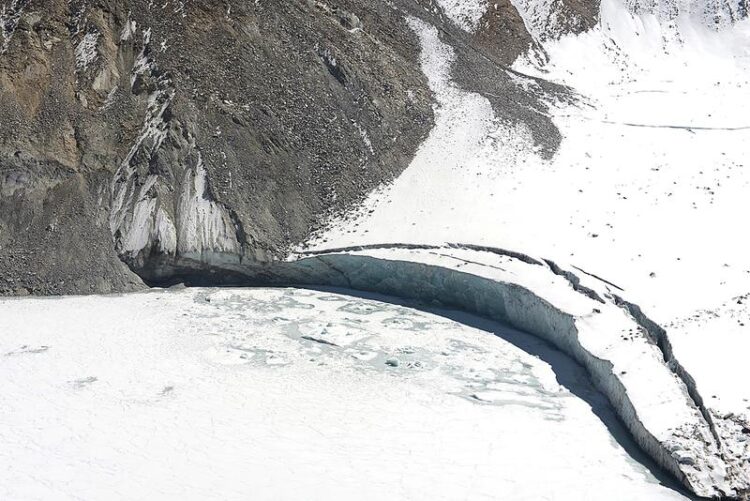Consequences of Glacier Shrinkage

The ice-covered Gya glacier lake shortly after the GLOF event
Marcus Nüsser
Heidelberg scientists study glacial lake outburst flood in the Himalaya
Researchers from the South Asia Institute and the Heidelberg Center for the Environment of Ruperto Carola investigated the causes of a glacial lake outburst with subsequent flooding in the Ladakh region of India. In order to frame the case study in a larger picture, the research team led by geographer Prof. Dr Marcus Nüsser used satellite images to create a comprehensive survey of glacial lakes for the entire Trans-Himalyan region of Ladakh. They were able to identify changes in the extent and number of glacial lakes over a 50-year period, including previously undocumented floods. This analysis allows them to better assess the future risk of such events, known as glacial lake outburst floods (GLOFs).
“In the wake of global glacier shrinkage caused by climate change, the danger from glacial lake outburst floods is seen as an increasingly pressing problem,” explains Prof. Nüsser of the South Asia Institute. An event like this unleashes huge amounts of water. Flash floods, for example, can wreak havoc on villages, agricultural areas, and infrastructure. To find out more about such events, the Heidelberg researchers studied a glacial lake outburst flood in Ladakh that destroyed houses, fields, and bridges in the village of Gya in August of 2014. Studies of the glacial lake, which is situated at 5,300 m above sea level, revealed a drastic short-tem lake level rise prior to the GLOF.
The cause, as the scientists discovered, was a “previously little-known mechanism”. “Increased glacial melting caused the lake level to rise quite rapidly. Instead of resulting in spillover, however, the thawing ice cores in the moraine, i.e. the glacier’s debris field, drained through subsurface tunnels without disturbing the moraine’s surface,” states Nüsser. In addition to conducting field surveys, the scientists also interviewed the locals about their recollections of the GLOF event. On the basis of satellite images, the team additionally studied the evolution of the glacial lake since the 1960s in order to reconstruct possible GLOF events.
“The high temporal and high spatial remote sensing imagery from satellites supported by field surveys will allow us to better assess the possible risk of future outbursts in this region,” adds the Heidelberg geographer. In light of recurring GLOFs, the new inventory can help us “re-evaluate the hazards, identify vulnerable locations, and develop possible adaptation measures,” continues Nüsser. After the flood in Gya, for example, concrete walls were constructed along the undercut bank as a flood protection measure to safeguard the villages and fields from future floods.
The results of the research were published in the journal “Natural Hazards”.
Contact:
Communications and Marketing
Press Office
Phone +49 6221 54-2311
presse@rektorat.uni-heidelberg.de
Wissenschaftliche Ansprechpartner:
Prof. Dr Marcus Nüsser
South Asia Institute
Tel: +49 6221 54-15241
marcus.nuesser@uni-heidelberg.de
Originalpublikation:
S. Schmidt, M. Nüsser, R. Baghel, J. Dame: Cryosphere hazards in Ladakh: the 2014 Gya glacial lake outburst flood and its implications for risk assessment. Natural Hazards (2020); https://doi.org/10.1007/s11069-020-04262-8
Weitere Informationen:
http://www.sai.uni-heidelberg.de/geo/personen/marcus.php?lang=eng
Media Contact
All latest news from the category: Earth Sciences
Earth Sciences (also referred to as Geosciences), which deals with basic issues surrounding our planet, plays a vital role in the area of energy and raw materials supply.
Earth Sciences comprises subjects such as geology, geography, geological informatics, paleontology, mineralogy, petrography, crystallography, geophysics, geodesy, glaciology, cartography, photogrammetry, meteorology and seismology, early-warning systems, earthquake research and polar research.
Newest articles

New model of neuronal circuit provides insight on eye movement
Working with week-old zebrafish larva, researchers at Weill Cornell Medicine and colleagues decoded how the connections formed by a network of neurons in the brainstem guide the fishes’ gaze. The…

Innovative protocol maps NMDA receptors in Alzheimer’s-Affected brains
Researchers from the Institute for Neurosciences (IN), a joint center of the Miguel Hernández University of Elche (UMH) and the Spanish National Research Council (CSIC), who are also part of…

New insights into sleep
…uncover key mechanisms related to cognitive function. Discovery suggests broad implications for giving brain a boost. While it’s well known that sleep enhances cognitive performance, the underlying neural mechanisms, particularly…



